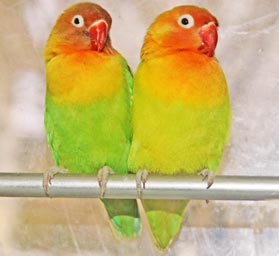
1.Eternal youth.
It is hard to tell how old a lovebird is. A new hatchling has a dark bar on its beak, which disappears when it is around 3 months old. Beyond that, it is anyone’s guess! That’s why some owners prefer placing bands with the date they were hatched. (You have to insert this when they’re chicks and small enough for the rings to slip over their feet.)
2.Tag of authenticity.
If you are buying an adult bird, look for the tag or closed ring. This is usually placed on exported birds so that it can be identified amid all the other birds. It is also a sign that the breeder is accredited or part of the breeding association. If you can’t find a tag, that may be a sign that it was caught or imported illegally. Also be careful if you are offered an expensive “rare” bird that belongs to a protected species. There are usually a long list of legal restrictions that outline when the bird can be sold, where it should be kept, and who can own it. If someone’s selling it to you “just like that” it is either a scam or an illegal transaction.
3.Identifying a healthy bird.
How do you know if your lovebird’s healthy? Look at its feathers. They should be shiny, and neatly lined up. The beak should also be even—poor nutrition or living conditions can lead to improper growth. Also be on the lookout for uneven breathing, or half-open eyes. Then, check the area around its tail feathers. Is it clean? Are the feathers dry, or sticky or wet with droppings? Then, check the check for protruding breast bones. Other warning signs are a swollen stomach and bluish skin color.
4.Lovebirds can be single!
You don’t have to buy a pair. A love bird can be perfectly happy being alone as long as it gets a lot of affection and attention from its owner. In effect, you will be its lifelong partner!
5. Girl or boy?
Not sure about the sex of your bird? Females generally have a wider head, shoulder and pelvic span. To check the latter, hold your bird so that its back lies against your palm. Gently hold down its wings with your thumb and little finger, while its head rests between your second and third fingers. Now, examine the belly area. Your finger should be able to detect two points of bone just on top of the tail. IF they are very close, you have a male. If the gap is wide enough for you to insert a finger, you have a female.